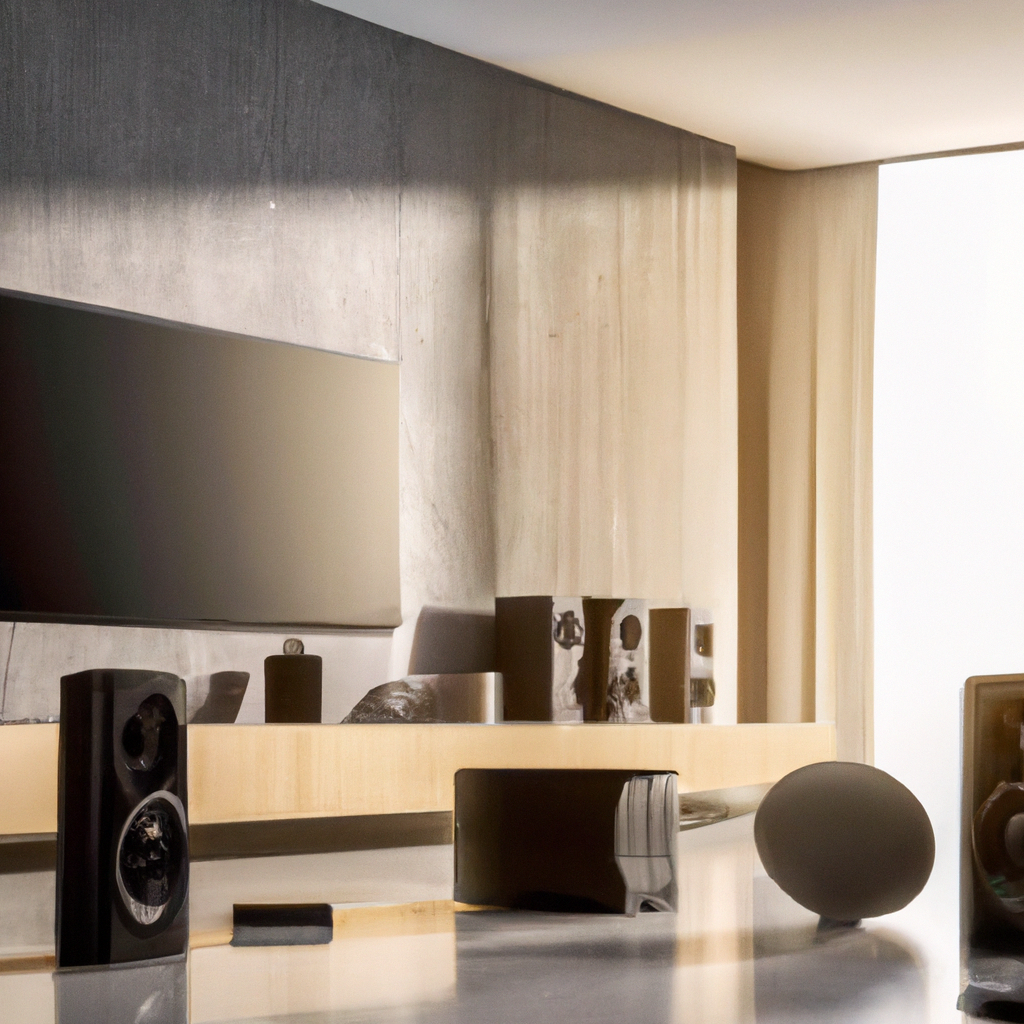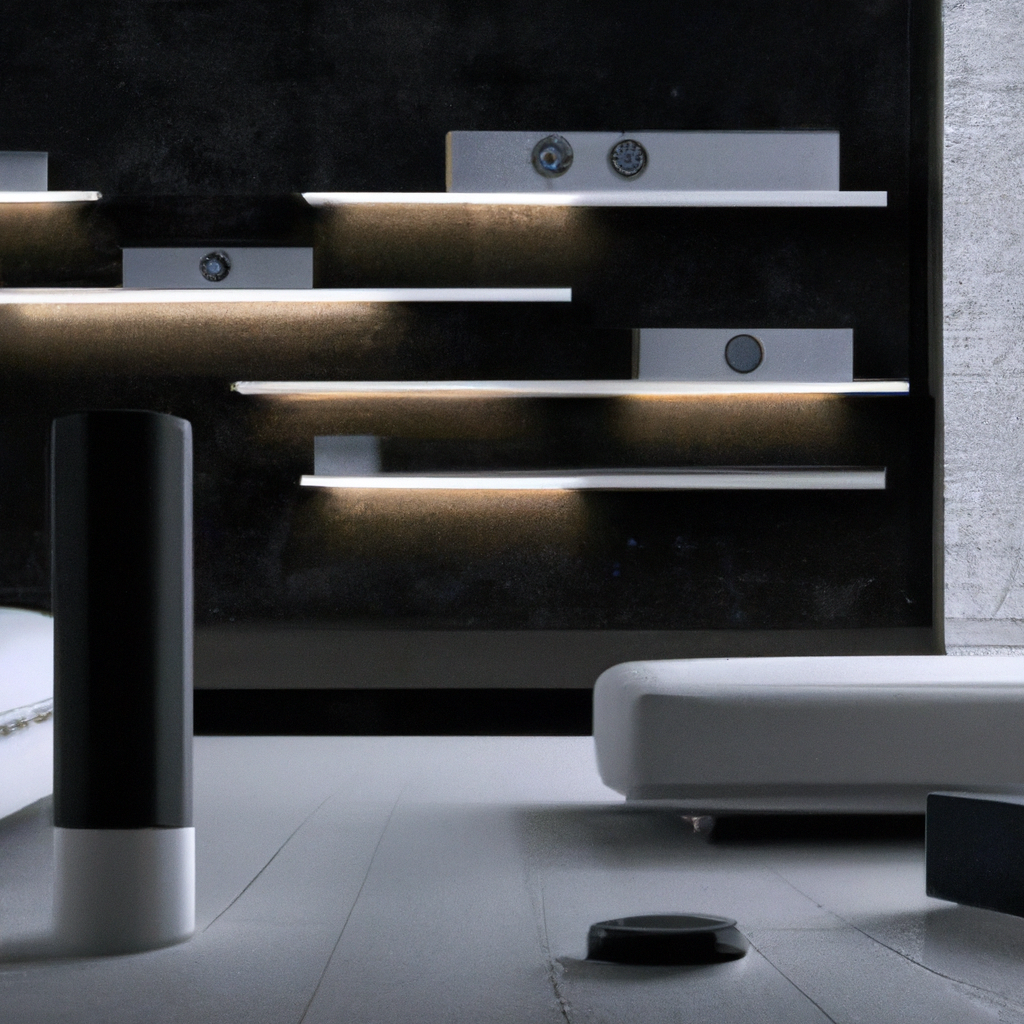You’re invited to explore the fascinating world of home theater audio and discover the incredible contributions that soundbars and smart speakers make to this immersive experience. From enhancing dialogue clarity to creating a more encompassing soundstage, these technological marvels elevate the way you enjoy movies and music in the comfort of your own home. So sit back, relax, and embark on a journey where your senses will be delighted by the power and precision of soundbars and smart speakers in home theater audio.

Enhancing Home Theater Audio Experience with Soundbars
Introduction to Soundbars
Soundbars are a popular choice for enhancing the audio experience in a home theater system. These sleek and compact devices are designed to deliver better sound quality compared to the built-in speakers of televisions. Soundbars are a convenient and cost-effective solution for those looking to improve the audio output of their home theaters without the need for multiple speakers and complex wiring.
Advantages of Soundbars over Traditional Speakers
One of the main advantages of soundbars is their simplicity and ease of setup. Unlike traditional speaker systems that require running wires and finding optimal speaker placements, soundbars can be placed right in front or below the television for an immersive audio experience. Additionally, soundbars often come with built-in amplifiers, eliminating the need for a separate receiver or amplifier.
Different Types of Soundbars
There are various types of soundbars available in the market, ranging from basic stereo soundbars to more advanced models with virtual surround sound capabilities. Some soundbars even come with additional wireless subwoofers for a deeper bass response. It’s essential to consider the size of the room and personal audio preferences when choosing a soundbar.
Features to Consider When Choosing a Soundbar
When selecting a soundbar for your home theater, several features should be taken into account. The number of audio channels, connectivity options, compatibility with the existing devices, and the availability of wireless connectivity should all be considered. Some soundbars also offer advanced features such as HDMI ARC support, Bluetooth streaming, and built-in smart assistants like Alexa or Google Assistant.
Setting Up a Soundbar in a Home Theater
Setting up a soundbar is a straightforward task that requires minimal effort. Most soundbars can be connected to the television using an HDMI cable or an optical audio cable. Additionally, many soundbars come with a wireless subwoofer, which can be placed anywhere in the room to enhance the low-frequency response. Once the soundbar is connected, it can be controlled using the provided remote control or sometimes even through a mobile app.
Utilizing Smart Speakers for Improved Home Theater Audio
Introduction to Smart Speakers
Smart speakers have gained immense popularity in recent years due to their ability to integrate with various smart home devices and provide voice-controlled assistance. These speakers are equipped with virtual assistants like Amazon Alexa or Google Assistant, allowing users to control their home theater audio using voice commands. Smart speakers are becoming an integral part of home theater systems, offering convenience and enhanced functionality.
Integration of Smart Speakers in Home Theater Systems
Smart speakers can be seamlessly integrated into home theater systems, providing an additional layer of control and connectivity. These speakers can act as a hub for smart home devices, allowing users to control lights, thermostats, and other devices using voice commands. When integrated with a home theater system, smart speakers can provide hands-free control over audio playback, volume adjustment, and even playback of specific content through streaming services.
Voice Control and Smart Assistant Features
The inclusion of smart assistants in smart speakers allows for voice-controlled operations of the home theater system. Users can simply issue verbal commands to play or pause audio, adjust volume levels, switch inputs, and even control the playback of specific movies or songs. This hands-free control eliminates the need for physical remote controls or mobile apps, enhancing the overall user experience and convenience.
Benefits of Using Smart Speakers in Home Theater
Apart from the seamless integration and voice control capabilities, smart speakers offer several other benefits when used in a home theater setup. These speakers often come with high-quality audio drivers, ensuring excellent sound reproduction. Additionally, smart speakers can be easily expanded to create a multi-room audio system, allowing users to enjoy synchronized audio playback in different areas of their home. Moreover, with regular software updates, smart speakers can constantly improve and add new features, making them future-proof investments.
Setting Up Smart Speakers with Home Theater Systems
Setting up smart speakers with a home theater system is a straightforward process. Most smart speakers connect to the home network via Wi-Fi, enabling them to communicate with other smart devices and streaming services. Once connected, the smart speaker can be linked to the home theater system either through a wired or wireless connection. Users can follow the manufacturer’s instructions to pair the speaker with the home theater receiver or control the audio output directly from the smart speaker.
Wireless Connectivity and Home Theater Audio
Wireless Audio Transmission Technology
Wireless connectivity has revolutionized home theater audio systems by eliminating the need for cumbersome cables and complicated wiring setups. Various wireless audio transmission technologies, such as Bluetooth, Wi-Fi, and proprietary wireless protocols, enable seamless audio streaming between devices. These wireless technologies ensure a clutter-free setup while providing high-quality audio transmission for an immersive home theater experience.
Benefits of Wireless Connectivity in Home Theater Systems
Wireless connectivity offers several benefits when it comes to home theater systems. Firstly, it eliminates the need for long cables, making it easier to set up and rearrange the audio components. Additionally, wireless connections provide more flexibility in speaker placement as speakers can be positioned anywhere within range without worrying about cable lengths. Moreover, wireless audio transmission technologies deliver high-quality audio without any noticeable loss in sound fidelity.
Wireless Options for Soundbars and Smart Speakers
Both soundbars and smart speakers offer wireless connectivity options for seamless audio playback. Soundbars often feature Bluetooth or Wi-Fi connectivity, allowing users to stream audio from their smartphones or tablets directly to the soundbar. Smart speakers, on the other hand, are primarily designed for wireless connectivity, enabling users to stream audio from various sources using Wi-Fi or Bluetooth. Additionally, some smart speakers support multi-room audio, where multiple speakers can be wirelessly synced to provide synchronized audio playback throughout the home.
Challenges and Limitations of Wireless Audio
Despite the numerous advantages of wireless audio, there are a few challenges and limitations to consider. One common limitation is the range of wireless transmission, as the audio quality may degrade if the devices are too far apart. Additionally, wireless connections can be affected by interference from other wireless devices or obstacles like walls or furniture. Finally, some wireless audio technologies may introduce a slight audio delay, which can be noticeable when watching movies or playing video games.
Surround Sound and Immersive Audio Technology
Importance of Surround Sound in Home Theaters
Surround sound is a key component of a truly immersive home theater experience. It creates a three-dimensional audio environment where sound effects and music come from different directions, enhancing the realism and depth of the audio. Surround sound allows viewers to feel fully immersed in movies, TV shows, or video games, creating a more captivating and engaging entertainment experience.
Soundbars with Surround Sound Capabilities
While traditional surround sound systems typically use multiple speakers positioned around the room, soundbars have evolved to offer virtual surround sound capabilities. These soundbars utilize advanced audio processing algorithms to simulate surround sound effects without the need for additional speakers. Some soundbars even have dedicated rear speakers or upward-firing drivers to create a more immersive surround sound experience.
Smart Speakers with Surround Sound Features
Smart speakers, in conjunction with other smart devices like receivers or amplifiers, can also provide surround sound capabilities. By connecting multiple smart speakers wirelessly, users can create a multi-channel audio setup that delivers immersive surround sound. Additionally, certain smart speakers feature audio beamforming technology, which directs sound towards specific listening areas, creating a virtual surround sound effect.
Immersive Audio Technologies for Home Theaters
Aside from surround sound, there are other immersive audio technologies designed to enhance the home theater audio experience. Object-based audio formats like Dolby Atmos and DTS:X enable audio engineers to position sounds precisely in a three-dimensional space, creating a more realistic and immersive soundstage. These technologies provide an elevated audio experience, delivering precise audio placement and movement to match the on-screen action.

Enhancing Sound Quality with Soundbars and Smart Speakers
Soundbar Audio Technology and Enhancements
Soundbars utilize various audio technologies and enhancements to deliver improved sound quality. Many soundbars feature built-in amplifiers, which enhance the power and clarity of the audio output. Additionally, soundbars may incorporate technologies like Dolby Digital or DTS audio decoding to reproduce high-quality surround sound. Some high-end soundbars also incorporate advanced audio processing algorithms to optimize the sound based on the content being played.
Smart Speaker Audio Capabilities
Smart speakers have come a long way in terms of audio capabilities. While their primary function is to act as a voice-controlled assistant, manufacturers have prioritized improving the audio quality of these devices. Smart speakers now feature advanced audio drivers, enabling them to produce clear, detailed sound with enhanced bass response. Furthermore, certain smart speakers can adapt the audio output based on the room’s acoustics, delivering optimal sound quality in any environment.
Additional Audio Enhancements for Home Theaters
In addition to the audio technologies integrated into soundbars and smart speakers, there are other audio enhancements that can further improve the home theater experience. Subwoofers can be added to both soundbars and smart speaker setups to enhance the low-frequency response, ensuring a more impactful and immersive audio experience. Additionally, room acoustic treatments such as sound-absorbing panels or diffusers can minimize audio reflections and improve overall sound quality.
Combining Soundbars and Smart Speakers for Optimal Audio Quality
To achieve the best audio quality in a home theater setup, soundbars and smart speakers can be combined. By using a soundbar for the front and center channels and setting up smart speakers as surround speakers, users can create a hybrid system that delivers excellent sound reproduction and immersive surround sound. Integration between soundbars and smart speakers can be achieved through wired or wireless connections, depending on the specific devices used.
Smart Home Integration and Automation
Integration of Soundbars and Smart Speakers with Smart Home Systems
Soundbars and smart speakers seamlessly integrate with smart home systems, offering centralized control and automation. By connecting these devices to a smart home hub or controller, users can easily control their home theater audio alongside other smart devices such as lights, thermostats, and security systems. This integration enhances convenience by allowing users to create customized scenes or routines that automatically adjust audio settings based on specific activities or time of day.
Controlling Home Theater Audio with Voice Commands
One of the significant advantages of using soundbars and smart speakers is the ability to control home theater audio with voice commands. Users can simply issue voice commands to play or pause audio, adjust volume levels, switch inputs, or even request specific content from streaming services. This hands-free control eliminates the need to search for remote controls or fumble with mobile apps, providing a more intuitive and user-friendly interface for managing audio playback.
Automated Audio Settings Based on User Preferences
Smart home integration enables automated audio settings based on user preferences and routines. For example, users can set up their smart home system to adjust the audio volume and sound modes when they start watching a movie or TV show. These customized audio settings ensure optimal audio performance without the need for manual adjustments every time. With advanced automation capabilities, users can create personalized audio experiences that cater to their individual preferences.
Integration with Other Smart Home Devices
Soundbars and smart speakers can integrate with other smart home devices to create a cohesive smart home ecosystem. By linking audio playback with other devices, such as lighting systems or motorized blinds, users can synchronize different aspects of their home theater experience. For example, when starting a movie, the lights can automatically dim, creating a more immersive viewing environment. Integrating these devices provides a streamlined and seamless home theater experience.

Versatility and Flexibility in Home Theater Setup
Compact and Versatile Design of Soundbars
Soundbars are known for their compact and sleek designs, making them an ideal choice for home theaters with limited space. Their slim profile allows for easy placement in front of or below the television, complementing the overall aesthetics of the room. With a single device, soundbars offer a complete audio solution, eliminating the need for multiple speakers and complicated wiring setups.
Flexible Placement Options for Soundbars
Another advantage of soundbars is their flexible placement options. Unlike traditional speaker systems that require careful positioning for optimal audio performance, soundbars can be placed in various locations without sacrificing sound quality. Some soundbars even come with wall mounting brackets, allowing users to mount them below or above the television, further maximizing space and improving the overall aesthetics of the home theater.
Mobility and Placement of Smart Speakers
Smart speakers offer even more mobility and placement options in a home theater setup. These portable devices can be easily moved to different areas of the room, providing flexibility in positioning and optimizing audio performance. Users can experiment with different placements and configurations to achieve the best sound quality. Additionally, smart speakers can connect wirelessly, eliminating the need for running cables and ensuring a clutter-free environment.
Multi-room Audio Setup with Smart Speakers
One of the key advantages of smart speakers is their ability to create a multi-room audio setup. Using multiple smart speakers, users can enjoy synchronized audio playback across different rooms or zones in their home. In a home theater context, this means that the audio from the main home theater system can be wirelessly transmitted to other smart speakers in different areas, allowing for a seamless transition from one room to another without missing a beat.
Budget Considerations and Cost-effectiveness
Affordability of Soundbars Compared to Traditional Speakers
One of the significant advantages of soundbars is their affordability compared to traditional speaker systems. While traditional speaker setups can involve purchasing multiple speakers and a receiver or amplifier, a soundbar offers a cost-effective all-in-one solution. Soundbars can provide a significant improvement in audio quality without breaking the bank, making them a popular choice for budget-conscious home theater enthusiasts.
Cost-effectiveness of Smart Speakers
Smart speakers, although originally designed as virtual assistants, also offer significant cost-effectiveness. In addition to their audio capabilities, they serve various smart home functions, allowing users to control other devices, stream music, and access streaming services. This multi-functionality minimizes the need for purchasing separate devices and offers value for money in terms of both audio quality and smart home integration.
Value for Money Considerations
When considering the value for money, both soundbars and smart speakers offer several advantages. Soundbars provide an improved audio experience at a fraction of the cost of a traditional surround sound system. They offer simplicity and convenience without compromising on sound quality. On the other hand, smart speakers offer an all-in-one package that combines audio capabilities with voice control and smart home integration, providing users with a versatile and cost-effective solution.
Long-term Investment and Upgradability
Investing in a soundbar or smart speaker for a home theater is a long-term investment. These devices often come with future-proof features, such as wireless connectivity or compatibility with the latest audio technologies. Upgradability is also a consideration, as manufacturers regularly release software updates or new models with improved features. By choosing reputable brands and investing in devices with a good track record, users can ensure their investment will last and remain relevant for years to come.

Compatibility and Connectivity with Different Devices
Connectivity Options for Soundbars
Soundbars offer multiple connectivity options to ensure compatibility with various devices. The most common connections include HDMI ARC (Audio Return Channel), digital optical, and Bluetooth. HDMI ARC allows for a single cable connection between the soundbar and the TV, enabling audio playback from the TV’s built-in apps or other connected devices. Digital optical connections are another popular choice, while Bluetooth allows for wireless streaming from smartphones, tablets, or other Bluetooth-enabled devices.
Compatibility of Soundbars with Televisions and AV Receivers
Soundbars are designed to be compatible with a wide range of televisions and AV receivers. They can be connected to most modern TVs using HDMI ARC, optical, or analog audio cables. Soundbars often come with multiple input options, ensuring compatibility with different audio sources. Additionally, many soundbars support HDMI CEC (Consumer Electronics Control), allowing the soundbar to be controlled using the TV remote.
Smart Speaker Integration with Home Theater Devices
Smart speakers seamlessly integrate with home theater devices through wireless connections. These devices can connect to the home theater receiver or other audio equipment using Wi-Fi or Bluetooth. By linking the smart speaker to the home theater system, users can control audio playback, adjust volume levels, and switch between different inputs without the need for multiple remotes or manual adjustments.
Streaming and Multimedia Capabilities
Both soundbars and smart speakers offer streaming and multimedia capabilities to enhance the home theater experience. Soundbars with Bluetooth connectivity allow users to stream audio from smartphones, tablets, or other devices. Some higher-end soundbars may also support built-in streaming services such as Spotify or Pandora. Smart speakers, on the other hand, offer extensive streaming capabilities through voice commands, enabling users to access music streaming services or play audio from their smartphones or other smart devices.
User-friendly Interface and Control Features
Easy Setup and User-friendly Interface of Soundbars
Soundbars are designed to be user-friendly and easy to set up. Most soundbars come with clear instructions and straightforward connection options. The provided remote control or mobile app allows users to control audio settings, switch inputs, and adjust volume levels effortlessly. Moreover, soundbars often feature intuitive LED displays or indicators, providing visual feedback for easy control and configuration.
Controlling Soundbars with Remote or Smart Devices
Soundbars can be controlled using the included remote control, which offers access to various audio settings and functions. Additionally, some soundbars can be controlled using a mobile app, allowing users to adjust audio settings, switch inputs, or even configure sound modes from their smartphones or tablets. This versatility ensures that users can choose the control method that suits their preference and convenience.
Smart Speaker Control and Streaming Options
Smart speakers offer multiple control options to suit different user preferences. The primary method of control is through voice commands, where users can simply speak to the smart speaker to initiate audio playback, adjust volume, or switch between different sources. Additionally, users can control smart speakers using a dedicated mobile app, offering convenient access to advanced audio settings and customization options. Some smart speakers also feature physical touch controls for quick adjustments without relying on voice commands.
Customizing Audio Settings with Smart Apps
Both soundbars and smart speakers often come with dedicated mobile apps that offer advanced audio settings and customization options. Users can fine-tune the sound profile, adjust equalizer settings, and even set up custom presets for specific types of content or listening preferences. These apps provide a more in-depth level of control over the audio output, allowing users to tailor the sound to their liking and optimize the audio performance according to their preferences.
In conclusion, soundbars and smart speakers contribute significantly to enhancing the home theater audio experience. Soundbars provide improved sound quality, simplicity of setup, and a cost-effective alternative to traditional speaker systems. Smart speakers offer seamless integration with smart home devices, hands-free voice control, and multi-room audio capabilities. Both devices incorporate wireless connectivity, surround sound features, and advanced audio technologies to create a more immersive and enjoyable home theater environment. Whether it’s enhancing sound quality, simplifying control, or expanding audio capabilities, soundbars and smart speakers are valuable additions to any home theater setup.











